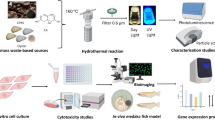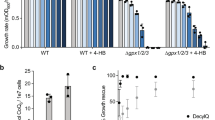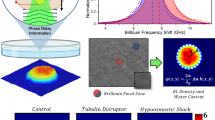Abstract
Quantum dots (QDs) exhibit fluorescence properties with promising prospects for biomedical applications; however, the QDs synthesized in organic solvents shows poor biocompatibility, limiting their use in biological systems. We developed an approach for synthesizing QDs in live cells by coupling a series of intracellular metabolic pathways in a precise spatial and temporal sequence. We have validated this approach in yeast (Saccharomyces cerevisiae), Staphylococcus aureus, Michigan Cancer Foundation-7 (MCF-7) and Madin-Darby canine kidney (MDCK) cells. The intracellularly synthesized QDs are inherently stable and biocompatible, making them suitable for the direct in situ labeling of cells and cell-derived vesicles. Here, we provide an optimized workflow for the live-cell synthesis of QDs by using S. cerevisiae, S. aureus or MCF-7 cells. In addition, we detail a cell-free aqueous synthetic system (quasi-biosynthesis) containing enzymes, electrolytes, peptides and coenzymes, which closely mimics the intracellular synthetic conditions used in our cell culture system. In this solution, we synthesize biocompatible ultrasmall QDs that are easier to purify and characterize than those synthesized in cells. The live-cell-synthesized QDs can be used for bioimaging and microvesicle detection, whereas the quasi-biosynthesized QDs are suitable for applications such as biodetection, biolabeling and real-time imaging. The procedure can be completed in 3–4 d for live-cell QD synthesis and 2 h for the quasi-biosynthesis of QDs. The procedure is suitable for users with expertise in chemistry, biology, materials science and synthetic biology. This approach encourages interested researchers to engage in the field of QDs and develop further biomedical applications.
Key points
-
In yeast, selenium and cadmium are supplied to the culture, where they are taken up by cells, to intracellularly generate CdSe QDs by the converging of glutathione/NADPH-involved selenite reduction and Cd2+ detoxication pathways.
-
The live-cell synthesis of QDs can be replicated in an aqueous solution that closely mimics the intracellular environment containing enzymes, electrolytes, peptides, coenzymes and metal ions.
This is a preview of subscription content, access via your institution
Access options
Access Nature and 54 other Nature Portfolio journals
Get Nature+, our best-value online-access subscription
$32.99 / 30 days
cancel any time
Subscribe to this journal
Receive 12 print issues and online access
$259.00 per year
only $21.58 per issue
Buy this article
- Purchase on SpringerLink
- Instant access to full article PDF
Prices may be subject to local taxes which are calculated during checkout











Similar content being viewed by others
References
Liu, S. L. et al. Single-virus tracking: from imaging methodologies to virological applications. Chem. Rev. 120, 1936–1979 (2020).
Liu, A. A. et al. Artificially regulated synthesis of nanocrystals in live cells. Natl Sci. Rev. 9, nwab162 (2022).
Cui, R. et al. Living yeast cells as a controllable biosynthesizer for fluorescent quantum dots. Adv. Funct. Mater. 19, 2359–2364 (2009).
Luo, Q. Y. et al. Nanomechanical analysis of yeast cells in CdSe quantum dot biosynthesis. Small 10, 699–704 (2013).
Li, Y. et al. Mechanism-oriented controllability of intracellular quantum dots formation: the role of glutathione metabolic pathway. ACS Nano 7, 2240–2248 (2013).
Xiong, L. H. et al. Uniform fluorescent nanobioprobes for pathogen detection. ACS Nano 8, 5116–5124 (2014).
Wu, C. Q. et al. Intracellular redox potential-driven live-cell synthesis of CdSe quantum dots in Staphylococcus aureus. Sci. China Chem. 67, 990–999 (2023).
Li, X. et al. Thioredoxin pathway regulated live-cell synthesis of CdSe quantum dots in Saccharomyces cerevisiae. Sci. China Chem. 67, 3851–3860 (2024).
Zhang, R. et al. ATP synthesis in the energy metabolism pathway: a new perspective for manipulating CdSe quantum dots biosynthesized in Saccharomyces cerevisiae. Int. J. Nanomed. 12, 3865–3879 (2017).
Shao, M. et al. Living cell synthesis of CdSe quantum dots: manipulation based on the transformation mechanism of intracellular Se-precursors. Nano Res. 11, 2498–2511 (2018).
Xiong, L. H. et al. Harnessing intracellular biochemical pathways for in vitro synthesis of designer Tellurium nanorods. Small 11, 5416–5422 (2015).
Bao, H., Hao, N., Yang, Y. & Zhao, D. Biosynthesis of biocompatible cadmium telluride quantum dots using yeast cells. Nano Res. 3, 481–489 (2010).
Wang, X. M. et al. Highly efficient near-infrared photothermal antibacterial membrane with incorporated biogenic CuSe nanoparticles. Chem. Eng. J. 405, 126711 (2021).
Yamaguchi, T. et al. Synthesis of CdSe quantum dots using Fusarium oxysporum. Materials 9, 855 (2016).
Tian, L. J. et al. Biogenic quantum dots for sensitive, label-free detection of mercury ions. ACS Appl. Bio Mater. 2, 2661–2667 (2019).
Chen, M. T. et al. Spatially directed biosynthesis of quantum dots via spidroin templating in Escherichia coli. Angew. Chem. Int. Ed. Engl. 61, e202214177 (2022).
Kang, S. H. et al. Microbial synthesis of CdS nanocrystals in genetically engineered E. coli. Angew. Chem. Int. Ed. Engl. 47, 5186–5189 (2008).
Li, D. B. et al. Selenite reduction by Shewanella oneidensis MR-1 is mediated by fumarate reductase in periplasm. Sci. Rep. 4, 3735 (2014).
Lin, T. Y. et al. Rapid biosynthesis of fluorescent CdSe QDs in Bacillus licheniformis and correlative bacterial antibiotic change assess during the process. Luminescence 36, 621–630 (2020).
Yan, Z. Y. et al. A sensitive and simple method for detecting Cu2+ in plasma using fluorescent Bacillus amyloliquefaciens containing intracellularly biosynthesized CdSe quantum dots. Enzym. Microb. Tech. 119, 37–44 (2018).
Cao, K. et al. The biosynthesis of cadmium selenide quantum dots by Rhodotorula mucilaginosa PA-1 for photocatalysis. Biochem. Eng. J. 156, 107497 (2020).
Tian, L. J. et al. A sustainable biogenic route to synthesize quantum dots with tunable fluorescence properties for live cell imaging. Biochem. Eng. J. 124, 130–137 (2017).
Xiong, L. H. et al. Designer cell-self-implemented labeling of microvesicles in situ with the intracellular-synthesized quantum dots. Sci. China Chem. 63, 448–453 (2020).
Hu, Y. et al. In-situ synthesis of quantum dots in the nucleus of live cells. Natl Sci. Rev. 11, nwae021 (2024).
Cui, Y. H. et al. Synthesis of CdS1−xSex quantum dots in a protozoa Tetrahymena pyriformis. Appl. Microbiol. Biotechnol. 103, 973–980 (2018).
Cui, Y. H. et al. Solar-energy-facilitated CdSxSe1−x quantum dot bio-assembly in Escherichia coli and Tetrahymena pyriformis. J. Mater. Chem. A 7, 6205–6212 (2019).
Li, L. L. et al. Selenium stimulates cadmium detoxification in Caenorhabditis elegans through thiols-mediated nanoparticles formation and secretion. Environ. Sci. Technol. 53, 2344–2352 (2019).
Gu, Y. P. et al. Ultrasmall near-infrared Ag2Se quantum dots with tunable fluorescence for in vivo imaging. J. Am. Chem. Soc. 134, 79–82 (2012).
Medintz, I. L., Uyeda, H. T., Goldman, E. R. & Mattoussi, H. Quantum dot bioconjugates for imaging, labelling and sensing. Nat. Mater. 4, 435–446 (2005).
Smyth, T. et al. Surface functionalization of exosomes using click chemistry. Bioconjug. Chem. 25, 1777–1784 (2014).
Lee, J. et al. Liposome-based engineering of cells to package hydrophobic compounds in membrane vesicles for tumor penetration. Nano Lett. 15, 2938–2944 (2015).
Sakimoto, K. K., Wong, A. B. & Yang, P. Self-photosensitization of nonphotosynthetic bacteria for solar-to-chemical production. Science 351, 74–77 (2016).
Kornienko, N. et al. Spectroscopic elucidation of energy transfer in hybrid inorganic–biological organisms for solar-to-chemical production. Proc. Natl Acad. Sci. USA 113, 11750–11755 (2016).
Zhao, J. Y. et al. Ultrasmall magnetically engineered Ag2Se quantum dots for instant efficient labeling and whole-body high-resolution multimodal real-time tracking of cell-derived microvesicles. J. Am. Chem. Soc. 138, 1893–1903 (2016).
Yang, L. L. et al. Acid-resistant near-infrared II Ag2Se quantum dots for gastrointestinal imaging. Anal. Chem. 95, 15540–15548 (2023).
Zebibula, A. et al. Ultrastable and biocompatible NIR‐II quantum dots for functional bioimaging. Adv. Funct. Mater. 28, 1703451 (2017).
Kowshik, M. et al. Microbial synthesis of semiconductor PbS nanocrystallites. Adv. Mater. 14, 815–818 (2002).
Weekley, C. M. & Harris, H. H. Which form is that? The importance of selenium speciation and metabolism in the prevention and treatment of disease. Chem. Soc. Rev. 42, 8870–8894 (2013).
Tarze, A. et al. Extracellular production of hydrogen selenide accounts for thiol-assisted toxicity of selenite against Saccharomyces cerevisiae. J. Biol. Chem. 282, 8759–8767 (2007).
Pedrajas, J. R. et al. Identification and functional characterization of a novel mitochondrial thioredoxin system in Saccharomyces cerevisiae. J. Biol. Chem. 274, 6366–6373 (1999).
Zhu, Y. et al. Biosynthesis of selenium nanoparticles and effects of selenite, selenate, and selenomethionine on cell growth and morphology in Rahnella aquatilis HX2. Appl. Microbiol. Biotechnol. 102, 6191–6205 (2018).
Gray, J. V. et al. “Sleeping beauty”: quiescence in Saccharomyces cerevisiae. Microbiol. Mol. Biol. Rev. 68, 187–206 (2004).
Cyrne, L., Martins, L., Fernandes, L. & Marinho, H. S. Regulation of antioxidant enzymes gene expression in the yeast Saccharomyces cerevisiae during stationary phase. Free Radic. Biol. Med. 34, 385–393 (2003).
Gasch, A. P. & Werner-Washburne, M. The genomics of yeast responses to environmental stress and starvation. Funct. Integr. Genomics 2, 181–192 (2002).
Cui, R. et al. Near-infrared electrogenerated chemiluminescence of ultrasmall Ag2Se quantum dots for the detection of dopamine. Anal. Chem. 84, 8932–8935 (2012).
Ge, J. P., Xu, S., Liu, L. P. & Li, Y. D. A positive‐microemulsion method for preparing nearly uniform Ag2Se nanoparticles at low temperature. Chemistry 12, 3672–3677 (2006).
Cheng, L., Liu, X., Lei, J. & Ju, H. Low-potential electrochemiluminescent sensing based on surface unpassivation of CdTe quantum dots and competition of analyte cation to stabilizer. Anal. Chem. 82, 3359–3364 (2010).
Mikulec, F. V. et al. Organometallic synthesis and spectroscopic characterization of manganese-doped CdSe nanocrystals. J. Am. Chem. Soc. 122, 2532–2540 (2000).
Jing, L. et al. Magnetically engineered semiconductor quantum dots as multimodal imaging probes. Adv. Mater. 26, 6367–6386 (2014).
Kalavagunta, C., Michaeli, S. & Metzger, G. J. In vitro Gd‐DTPA relaxometry studies in oxygenated venous human blood and aqueous solution at 3 and 7 T. Contrast Media Mol. Imaging 9, 169–176 (2014).
Acknowledgements
We thank Z.-L. Zhang, Z. Xie, H.-H. Liu, Y. Li, Y.-P. Gu, L.-H. Xiong, C.-Q. Wu and X. Li for their work and contributions to the project. This work was supported by the National Natural Science Foundation of China (Nos. 22293030, 22293032, 21535005, 20921062, 20621502 and 20025311) and the National Basic Research Program of China (973 Program, 2006CB933100 and 2011CB933600).
Author information
Authors and Affiliations
Contributions
D.-W.P. is the group leader who conceived and initiated the project and supervised the study and the entire manuscript preparation. R.C., J.-Y.Z. and Y.H. developed the procedures for live-cell synthesis and quasi-biosynthesis of QDs and data processing. A.-A.L., X.Z. and J.J. organized and wrote the manuscript. All authors reviewed and edited the manuscript and approved the final draft.
Corresponding author
Ethics declarations
Competing interests
The authors declare no competing interests.
Peer review
Peer review information
Nature Protocols thanks Dhiraj Bhatia and the other, anonymous, reviewer(s) for their contribution to the peer review of this work.
Additional information
Publisher’s note Springer Nature remains neutral with regard to jurisdictional claims in published maps and institutional affiliations.
Key references
Hu, Y. S. et al. Natl Sci. Rev. 11, nwae021 (2024): https://doi.org/10.1093/nsr/nwae021
Xiong, L. H. et al. ACS Nano 8, 5116–5124 (2014): https://doi.org/10.1021/nn501174g
Zhao, J. Y. et al. J. Am. Chem. Soc. 138, 1893–1903 (2016): https://doi.org/10.1021/jacs.5b10340
Cui, R. et al. Adv. Funct. Mater. 19, 2359–2364 (2009): https://doi.org/10.1002/adfm.200801492
Gu, Y. P. et al. J. Am. Chem. Soc. 134, 79–82 (2012): https://doi.org/10.1021/ja2089553
Rights and permissions
Springer Nature or its licensor (e.g. a society or other partner) holds exclusive rights to this article under a publishing agreement with the author(s) or other rightsholder(s); author self-archiving of the accepted manuscript version of this article is solely governed by the terms of such publishing agreement and applicable law.
About this article
Cite this article
Liu, AA., Cui, R., Zong, X. et al. Live-cell synthesis of biocompatible quantum dots. Nat Protoc 20, 1884–1914 (2025). https://doi.org/10.1038/s41596-024-01133-5
Received:
Accepted:
Published:
Issue date:
DOI: https://doi.org/10.1038/s41596-024-01133-5



